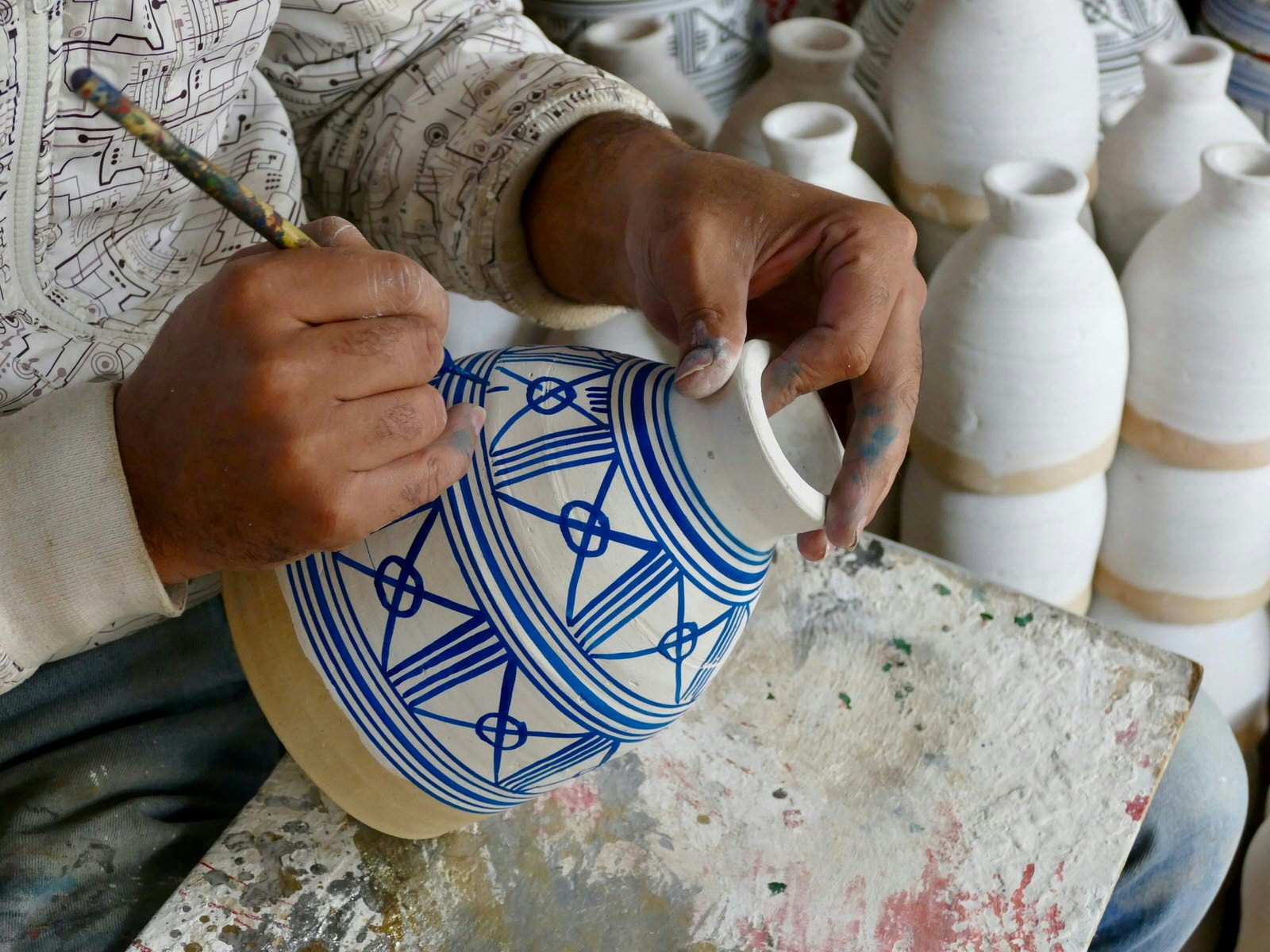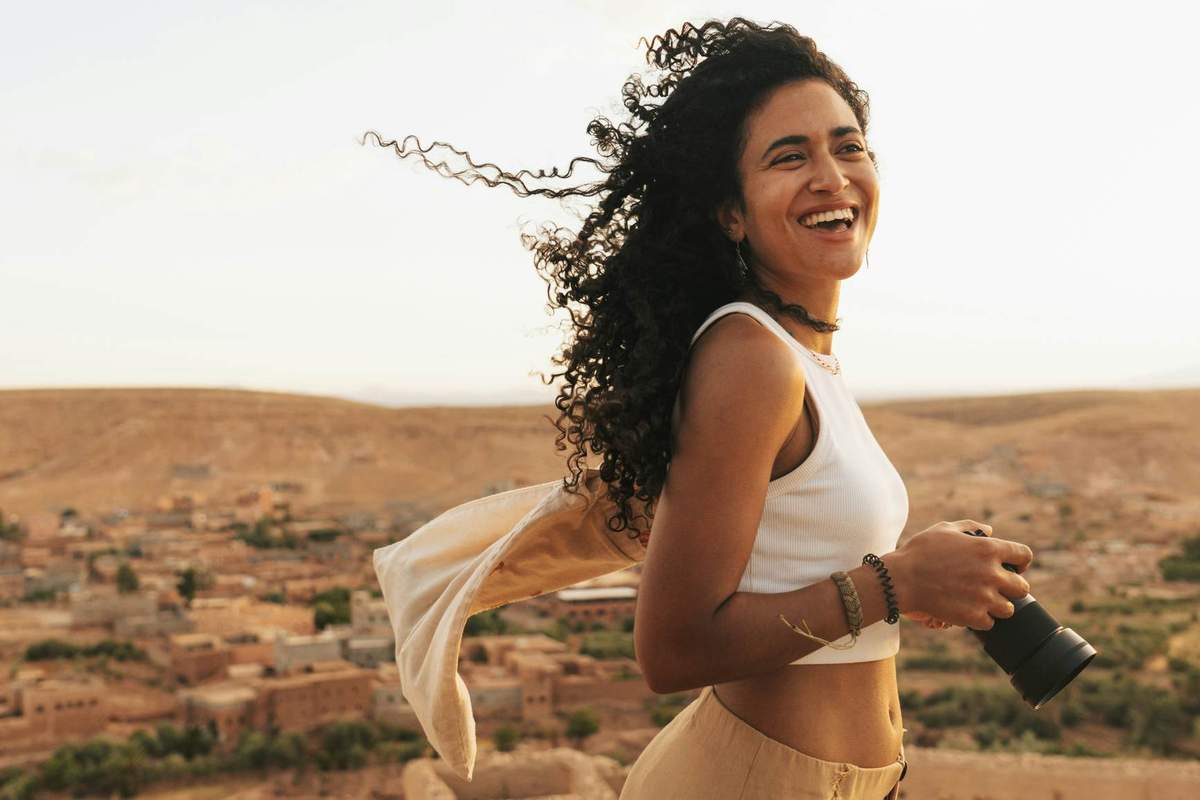Makers of Morocco: finding local crafts and their creators in Fez

Sep 24, 2018 • 6 min read

For centuries, the imperial city of Fez has been one of the world’s great craft centres. Along the medieval medina’s twisting alleyways, time-honoured traditions of leatherwork, brass etching, woodcarving and more have been handed down through the generations.
As today’s Fassi artisans face increasing competition from machine-made and imported goods, newly restored funduqs – ancient inns once used by travelling merchants – are being transformed into hubs for disappearing crafts, designers are breathing new life into age-old techniques, and you can go behind-the-scenes on interactive tours.

Meet the artisans with Culture Vultures
On the half-day Artisanal Affairs tour from Culture Vultures, you’ll pound the lanes of the medina and get the chance to meet and – with the aid of your guide – talk to craftspeople in their workshops, including weavers, wood painters and leather makers, depending on your interests and who’s around on the day.
Perhaps you'll encounter 87-year-old Abdelkhader El Ouazzani, who still sits at his wooden loom, hands and feet working the complex maze of 4000 interlinked threads stretched out before him, creating a length of shimmering silk brocade that today could just as easily be for a New York fashionista as a Fassi bride. Or maybe it will be Abdul and Nordeen in their wardrobe-sized workshop, putting the finishing touches to an ornately painted wooden door destined for the Middle East that no machine can recreate.
Culture Vultures can also take you around Fez’s artisan school in Batha. Not so long ago, trades were passed down from master craftsmen to child apprentices, who spent years honing their skills instead of going to school. Now would-be artisans can learn more than 20 trades in this modern space, as well as taking classes in literacy, marketing and computing. You can watch as woodworkers, plaster carvers and babouche (the ubiquitous pointed leather slippers) makers pass on their expert knowledge and listen to the traditional songs they sing while working, as well as purchasing their products.

Get hands on
If you're not content with watching from the sidelines, signing up for a Craft Draft workshop with social entrepreneur and multi-talented artisan Hamza El Fasiki will introduce you to the world of Fassi crafts, including bookbinding, brass etching and leather embossing. His father was a master craftsman, and examples of his fine brass etching decorate the studio. Hamza served as his apprentice, and he begins by describing the evolution of a craftsman, from pupil to master, and explaining a few of the 1000 tools used in brass and gold etching, each with its own name.
If you opt to make a leather-bound book, you’ll sit down at the workbench with just a compass for drawing circles, a metal scorer for lines and a ruler – although there’s no measuring involved in copying Hamza’s Islamic-inspired cover design; it’s all done by eye. As he puts it, 'no perfection, no eraser'. Hamza also makes his own paper, and he’ll give you the ready-prepared folded sheets, known as a signature, before demonstrating Coptic-style binding, a rhythmic plaiting and looping with a needle and thread. After three hours, you’ll emerge with your own handcrafted, beautifully imperfect book.

Artisanal tours are also available from Plan-it Morocco, where you can learn to make slippers, throw a pot or bang your own drum with the artisans. In a tucked away funduq off one of the medina’s main arteries, you’ll find a drum-making production line in full swing. This collaborative process involves three men: one to paint the ceramic base, another to remove the fat and hair from a camel hide (the least enviable task) and the third to stitch the skin tightly over the base. At the neighbouring leather workshop, you can hand stitch your own pair of Fassi yellow babouche, traditionally for men and made with goatskin on top, cowhide on the bottom and soft sheepskin on the inside.
Fez also has a long history of pottery making, and on the outskirts of the city, you’ll discover the age-old process behind its famous blue-and-white ceramics with their intricate geometric patterns, from shaping the clay on a foot-operated potter's wheel – much harder than it looks – to drying it in the sun, hand painting and firing in the red-hot kiln.

Where to shop in the medina
Fassi handicrafts were once carried across continents by camel trains, and travelling merchants lodged in funduqs, inns where they stored their wares. Animals were parked on the ground floor, and the merchants slept upstairs. Many of these architectural gems were abandoned and lie in ruins, but now an ambitious restoration – part of a project between ADER-Fès and the US Millennium Challenge Corporation – has seen four of Fez's funduqs returned to their former glory, all soaring stone columns and fragrant cedar wood balustrades.
The 13th-century Chemmaine-Sbitryine funduqs on Rue Quaraouyine are dedicated to disappearing crafts, such as wooden hammam buckets (most public hammams have switched to plastic), finely decorated fire bellows and colourful Fassi embroidery, with exhibition areas, cafes and spaces for the artisans to make and sell their wares. The Barka funduq on Rue Kettanine is devoted to women’s cooperatives. Many Moroccan women who previously worked from home and sold through a middleman now have an opportunity to showcase their work, from hand-stitched kaftans to hand-loomed carpets and necklaces made from buttons normally used on djellabas, the long, loose-fitting robes worn by both men and women.

For something more contemporary, head to Fez’s first concept store. Laurence Alberro opened Médin'ART at the end of 2014, and it’s become a hub for Moroccan and Morocco-based designers who are making classic crafts current. Fassi designs include embroidered T-shirts from Mawj, finely woven cotton and leather scarves from Mouhib and naïve weavings from Ashraf, a young, self-taught artist. You’ll also find the work of French-Moroccan designer Ytto, who decorates lampshades and cushions with the Amazigh (Berber) alphabet, and Jabi, an Italian man who works with local weavers and tailors, who uses sfifa – a strip of embroidery often found on kaftans – to edge stylish jackets, while Cecile’s creations include covetable bags made with sabra, Moroccan cactus silk.
At boutique riad hotel Le Jardin des Biehn, owner Michel Biehn – originally from Provence, France, and as knowledgeable as he is passionate about textiles – has created a microstore, where his curated collection includes exquisite vintage kaftans and djellabas, and shaggy boucherouite rugs (made from colourful scraps of wool and material woven together), as well as contemporary crafts. Among them are handwoven blankets from Artisan Project, founded in 2011 by Palestinian-American designer Nina Mohammad-Galbert who moved from California to Fez, and one-of-a-kind leather bags from Alfred Berlin, also known as Carmelo Tedeschi, an Italian artist and designer who splits his time between Fez and Berlin; both work with local craftspeople and help to keep traditional techniques alive.

Don’t miss one of the iconic sights (and smells) of the Fez medina: the medieval Chaouwara Tanneries, where you can look down on stone vats filled with vibrant dyes spread out like a painter’s palette, as animal hides are stripped, treated, dyed and dried in a process that’s barely changed since the 11th century. The surrounding shops sell all-things leather, from pouffes to slippers, bags to butter-soft jackets – you can get one made to order in 24 hours. Bargaining is expected, but only start haggling if you’re serious about buying.
https://shop.lonelyplanet.com/products/morocco-travel-guide-12
Plan with a local




